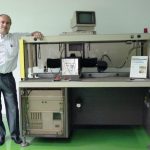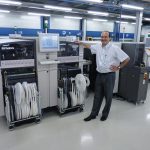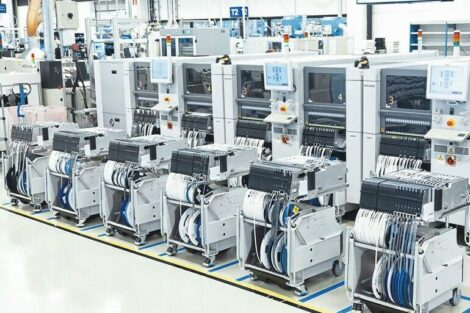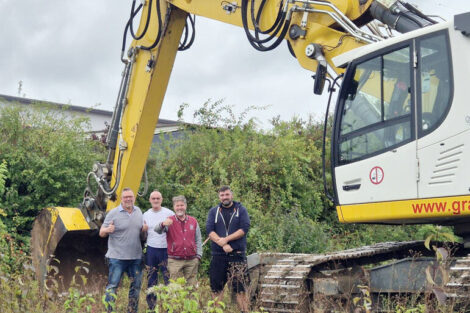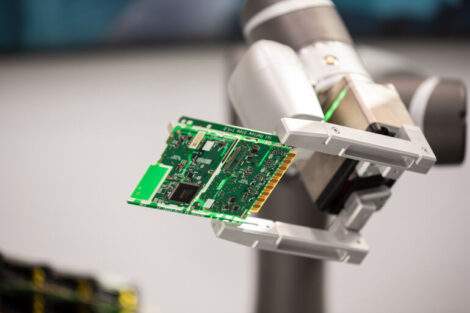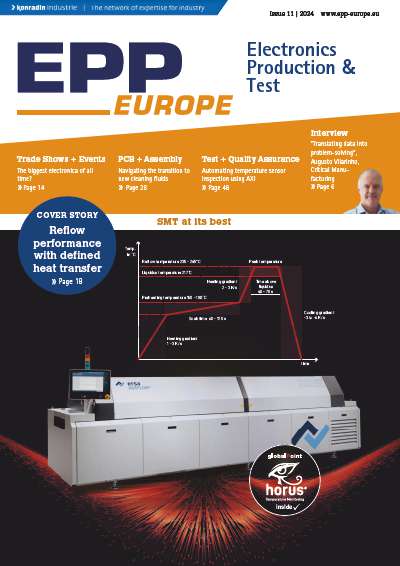Antennas, satellite receivers, signal amplifiers, distributors, set-top boxes, measuring devices – Spain’s Televes offers a broad portfolio of products for television and telecommunication transmission applications. Great manufacturing depth, high demands of development and quality and state-of-the-art manufacturing equipment form the cornerstones of the company’s extended success Televes is also one of the first companies in Europe to invest in a Siplace CA in order to combine its die and flip chip processing with classic SMT placement in a consistent and highly efficient process.
Thomas Hüttl, Siplace, Munich (Germany)
The bright orange electronics box on Spanish TV antennas are highly visible indicators of the company’s success. Since revolutionized the construction of receiving equipment in 1958 by switching from iron to aluminum for its antennas, it has been among the leading suppliers of television and telecommunication transmission technology in Europe.
When you visit the company in placid Santiago de Compostela, you experience a business that is definitely going places. For example, Televes exports almost 50 percent of its production, but its hometown in northwest Spain’s Galicia province is still its only SMT production site. This highly traditional company employs over 750 people, and despite the many crises in the dynamic electronics industry, staff has always been continuously increased, never decreased. Its unassuming production facilities are filled with state-of-the-art manufacturing equipment. Almost everything ranging from electronic modules to plastic housings to the metal frames of the junction boxes is produced in-house. Wherever possible, robots which own technicians program and modify for their specific applications perform precision labor. “Having a high degree of automation is our philosophy and the secret of our quality and efficiency. We have a special team whose only job is to come up with ways to make our processes even more efficient. Our depth of added value makes us independent and extremely flexible,” explains production manager Jorge Montero Gabarro.
Early start in SMT production
Considering the company’s philosophy, it should come as no surprise that the company jumped into the then-young SMT placement technology already in 1983. Visitors are still proudly shown the MS-72, the first Siplace placement machine deployed outside of Germany. “Imagine the future and make it real is the motto to which we have always remained true. We don’t select our production equipment on the basis of short-term considerations. We rather find technology partners who can stand by us for the long term with their innovations and services,” says Jorge Montero Gabarro.
Just like it did when it entered the SMT field, the company has always managed to benefit from technological jumps in manufacturing technology or in its target markets by making courageous decisions. Today, for example, the company profits from the conversion to high-definition digital television via DVB (Digital Video Broadcasting). Televes has a slew of patents for the trouble-free reception of the highly sensitive signals.
“We count on a lot more than patent protection for our inventions, however. To defend our technological advantage, we combine our developments with state-of-the-art manufacturing equipment,” says Jorge Montero Gabarro. “The signal processing technology in the HF field involves ever higher technical requirements and ever shorter circuit paths. Accordingly, our placement machines must operate with the corresponding level of precision. Our goal is to process the flip chips and bare dies we develop in-house directly from the wafer.”
Integration of bare die and classic SMD placement
Integrating bare die and SMD placement in a single machine was nothing but a concept when Montero and his team attended the 2009 Productronica in Munich. They already realized 2007, that Siplace is offering some kind of chip assembly solution, but the original purpose of their visit was to take a closer look at the new SX. The rising demand for Televes products made an additional SMT line necessary, because the existing lines with one Siplace S27 and one HF3 each were no longer able to handle the volume.
At the Siplace booth, the visitors examined the new SX platform. “The Siplace SX platform lets us cover all our current requirements. For our more than 250 products we need lots of flexibility, because our constantly changing requirements range from high-volume lots with 2,500 to 4,000 units to 19-unit lots to NPI processes”, says the production manager about the company’s decision in favor of the SX platform. “For us, the decision also meant that we had to invest in the new X-feeders, but their improved handling, the broad spectrum of the CPP head and the reliable processing of connectors and odd shapes with the TwinHead made the SX2 the machine of choice for us.” The new digital vision system of the SX also had a significant impact on Televes’s quality. New products can now be introduced with speed and reliability, because the flexible CPP head changes placement modes in accordance with the requirements, eliminating the need for cumbersome reconfigurations, head changeovers and NPI test runs.
The new CA was another model that attracted the managers’ attention at last year’s Productronica. “We saw right away that this was our future – a fast machine for our current SMT processes that also provides support for flip chip processing directly from the wafer,” says Jorge Montero Gabarro. Once again, the Siplace team is supporting its customer’s technology jump, just like it did during the introduction of surface mount technology. Today, the new line with one SX2 (equipped with one CPP head and one TwinHead) and one CA (equipped with two CP20 and two 12-nozzle heads) is in full operation and has expanded the production considerably. The company is also busy developing its own ICs; first tests operate with tray-based feeding. At the same time, Televes is evaluating the use of the new wafer module with a linear dip unit (LDU). For example, the joint team is examining which stretch films work best for the wafers so that multiple subsets can be removed from them to produce prototypes. “A separate flip chip placement process would have been inefficient, but the CA pays for itself with its classic SMD placement capabilities alone. Thanks to the technicians’ support we will be able to protect our technological advantage with our own ICs, which we will place directly from the wafer in a highly automated and efficient manner. I believe that his kind of integration is the ideal solution for high-mix producers like Televes,” concludes production manager Jorge Montero Gabarro.
ZUSAMMENFASSUNG
Die spanische Televés S.A., Hersteller professioneller Rundfunk- sowie Fernsehübertragungstechnik, und die Siemens Electronics Assembly Systems (SEAS) haben ihre seit mehr als 25 Jahren bestehende Zusammenarbeit vertieft. Um sich auf neue innovative Produkte und eine steigende Nachfrage vorzubereiten, hat Televés in eine neue Fertigungslinie investiert. Mit Bestückautomaten der Typen SX2 und CA kombiniert die neue Linie die klassische SMT-Bestückung mit der Verarbeitung von Die-Komponenten in einem durchgängigen, hochflexiblen Fertigungsprozess.
La société espagnole Televés S.A., fabricant de systèmes professionnels de transmission radiophonique et télévisuelle, et Siemens Electronics Assembly Systems (SEAS) ont intensifié leur collaboration engagée il y a plus de 25 ans. Pour se préparer à l’élaboration de produits novateurs et à une demande croissante, Televés a investi dans une nouvelle chaîne de fabrication. Equipée de systèmes d’assemblage SX2 et CA, celle-ci associe le montage TMS traditionnel au traitement de carrés de silicium dans le cadre d’un processus continu, ultra flexible.
Share:




